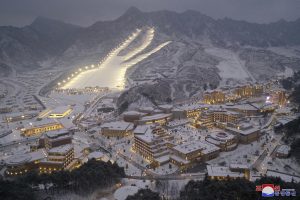North Korea is the only U.N. member state with which Japan does not have diplomatic relations. With ties deteriorating severely over the abductions of Japanese nationals, together with tensions over Pyongyang’s nuclear and missile program, Japan has imposed the strongest economic sanctions on North Korea. Trade between the two countries has remained non-existent for more than a decade, both in terms of exports and imports. As a researcher on North Korea, I would face charges of violating the Foreign Exchange Act even for importing a $1 book from Pyongyang.
However, the tourism sector is not subject to sanctions, making it a legitimate means of earning foreign currency for North Korea. North Korea also opened its doors to Americans, receiving as many as 200,000 foreign tourists a year before the COVID-19 pandemic. The majority of tourists were in fact Chinese, with only a few thousand visitors from Europe and Southeast Asian countries, as well as about 300 Japanese. In the 1990s, you could board a direct flight to Pyongyang from the major Japanese cities of Nagoya and Niigata, with the Japan Travel Bureau also offering tours of North Korea. Today, that feels like a very different world.
There is no doubt that the Kim Jong Un administration has a strong interest in inbound tourism. At the end of 2019, Yangdeok Hot Spring opened with a large hotel to great fanfare, with Kim personally cutting the ribbon. While the activities of foreign visitors are heavily restricted and controlled, there is a policy of “actively showing foreigners how North Korea looks.” Before the pandemic, Pyongyang was beginning to enjoy some economic growth. Compared to the Kim Jong Il era, the cityscape has improved to become barely recognizable, so the regime at least can take confidence in its appearance.
Of course, even if you do actually visit North Korea, there are almost no opportunities to talk with locals, and it is difficult to get a true picture of the country. Visit on a number of occasions, though, and you can begin notice economic and social changes. Take taxis, which were not in evidence at all when I first visited North Korea in 1994, but are now common not only in Pyongyang but also in regional cities such as Chongjin and Wonsan, albeit reserved for wealthy people.
North Korea began accepting Japanese tourists in 1987 when it joined the World Tourism Organization of the United Nations (UNWTO). Its objective in allowing inbound tourism has always been obvious: It is a means of earning foreign currency. Yet even greater emphasis has been on maintaining control over the regime’s narrative. For one thing, foreign tourists are never allowed wander freely without a guide. Moreover, North Korea does not issue visas to those it classes as undesirables. Control always has priority over currency.
Travelers to the former Soviet Union during the Cold War always found it difficult to change the preset means of transportation, destinations, and accommodation. However, you could move around pretty freely. North Korea is much stricter in that regard. In North Korea, at least two guides and one driver are assigned to foreigners as they enter the country, whether in groups or as individuals. The guides and driver are de facto watchdogs, staying in the same hotels and following the same itineraries, but they also play a role in preventing any trouble that may arise from the perceptional gaps that might be felt by people from the free world. In January 2016, an American college student who traveled to Pyongyang tried to steal a poster showing a political slogan at his hotel, for which he was detained by North Korean authorities, although this happened in the middle of the night while the guide was asleep. Swearing at the Supreme Leader and taking photographs in prohibited areas can also turn into major incidents.
On January 22, 2020, even before China had placed Wuhan in lockdown, North Korea stopped accepting tourists, and followed this 10 days later by suspending all international flights and trains. Construction of the large resort Wonsan Kalma Beach Tourist Area along North Korea’s eastern coast was originally slated to be complete in April that year, but was postponed indefinitely. Nearby is the scenic Mount Kumgang, which received nearly 2 million South Korean tourists from 1998 to 2008 and became a symbol of inter-Korean economic cooperation. After relations with Seoul soured, however, Kim himself ordered the demolition of all hotels and entertainment facilities built with South Korean investment, calling for them to be redeveloped by North Korea itself.
In Wonsan, the North Korean Sports Ministry will reportedly organize an international marathon in October this year. A course has already been announced, its selling point being that it is flat and runner friendly, since it follows the coast. The plan is to attract 1,500 runners from overseas.
Will the economic interest in bringing back foreign tourists outweigh the military interest in bolstering deterrence with more missile tests? That is entirely up to Kim. This fall marks the 75th anniversary of North Korea’s founding, and the question is whether a shift back to dialogue is discernable by that time. In that regard, the reopening – or not – of inbound tourism could be a useful barometer.

































